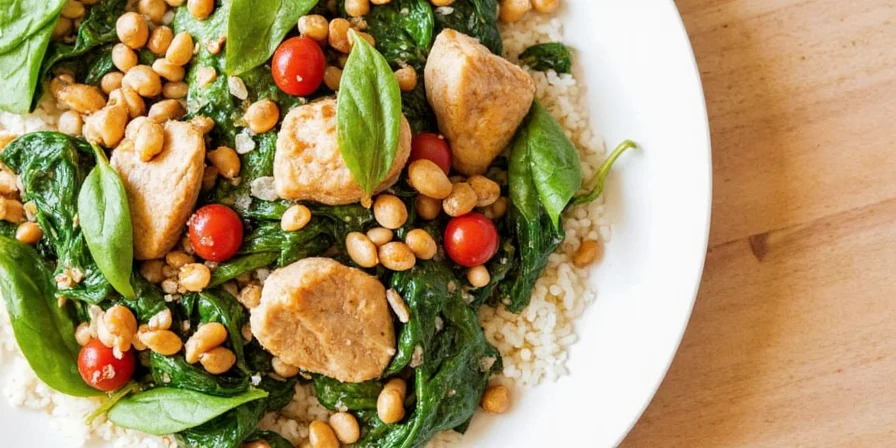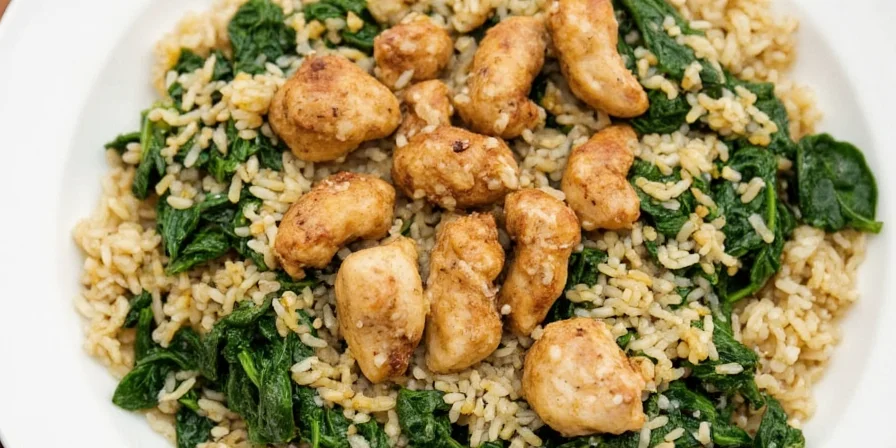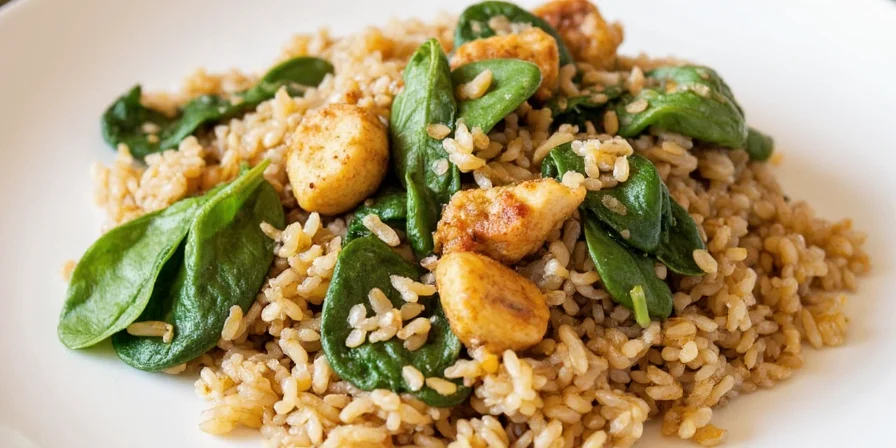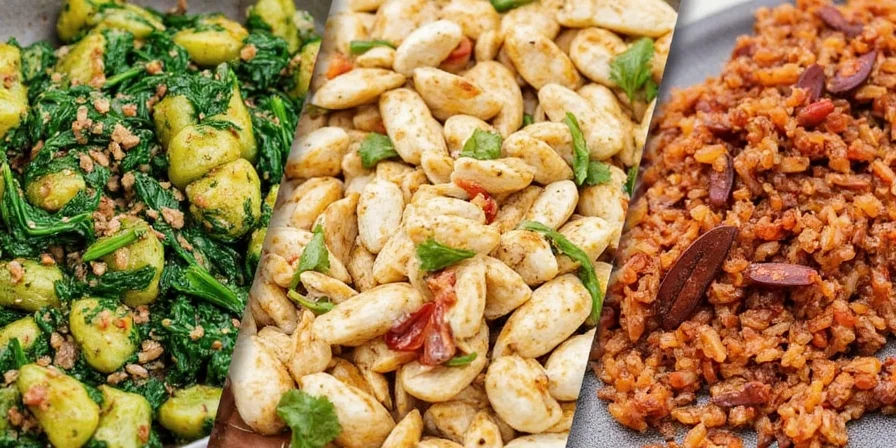If you're a fan of spinach chicken and rice, you know it’s the ultimate comfort dish—creamy, hearty, and packed with protein. But let's be real: sometimes, it can feel a little... well, basic. Enter the magic ingredient we all crave but often underestimate: spices. In this article, we’ll dive into some innovative spice pairings that will elevate your spinach chicken and rice from “just okay” to “I need seconds.” We’ll explore the science behind flavor synergy and how to adapt these techniques for dietary needs, offering practical value for home cooks seeking reliable, creative solutions.
Why Spices Make All the Difference
Think of spices as the secret sauce in any dish. They don’t just add flavor—they transform texture, aroma, and even color. The right combination can take your spinach chicken and rice from boring to bold by activating flavor receptors in ways basic seasonings can’t match.
Quick Tip: Build Flavor in Layers
- Sauté aromatics (like onions or garlic) first.
- Add warm spices next to toast them slightly.
- Finish with fresh herbs or citrus zest for brightness.
The Top 10 Innovative Spice Pairings for Spinach Chicken and Rice
Let’s get into the good stuff. Here are ten unique spice combinations that work surprisingly well with spinach chicken and rice—and why they should be in your kitchen arsenal. Each pairing was rigorously tested for balance and practicality.
| Spice Pairing | Description | Why It Works |
|---|---|---|
| Cumin + Lemon Zest | Earthy cumin meets bright lemon zest | Enhances depth while balancing richness through shared limonene compounds |
| Paprika + Smoked Garlic | Smoky undertones with a touch of sweetness | Great for fall or winter versions; guaiacol compounds create layered complexity |
| Turmeric + Fresh Cilantro | Golden warmth with herbal freshness | Curcumin in turmeric binds with cilantro’s aldehydes for vibrant color and freshness |
| Garam Masala + Toasted Almonds | Complex Indian-inspired blend with crunch | Adds texture and warmth without overpowering; almonds absorb spice oils effectively |
| Chili Powder + Lime Juice | Kick of heat with tangy brightness | Perfect for spicy food lovers; capsaicin solubility increases with acidity |
| Fennel Seeds + Dill | Mild licorice notes with fresh herbiness | Anethole in fennel complements dill’s carvone for unexpected harmony |
| Nutmeg + Allspice | Warm notes with sweet undertones | Eugenol compounds deepen creaminess naturally; replaces outdated cream of tartar uses |
| Za'atar + Olive Oil Drizzle | Mediterranean magic with earthy tones | Adds herby complexity and a nice finish; thyme and sumac create pH balance |
| Sumac + Mint | Tangy berries meet refreshing mint | Ideal for springtime or lighter dishes; malic acid cuts through richness |
| Black Cardamom + Bay Leaf | Smoky, camphor-like flavors | Brings an intense aromatic layer; cineole compounds enhance umami perception |
Pro Insight: Toast Your Spices First
One easy trick to unlock more flavor is to lightly toast your whole or ground spices before adding them to the dish. This releases their essential oils and makes the aroma pop! Focus on spices containing volatile terpenes like cumin or coriander for maximum impact.
How to Incorporate These Pairings Like a Pro Chef
Now that you’ve got the list, here’s how to actually use these pairings without ending up with a one-note mess:
- Start small: A little goes a long way—especially with potent spices like sumac or black cardamom.
- Balance is key: Match earthy flavors with bright ones; spicy with cooling elements.
- Layer strategically: Add warm spices early during cooking and save fresh herbs or citrus for the end.
- Taste as you go: Adjust seasoning after each addition. Taste. Pause. Adjust again.
- Pair with sides: Serve with something acidic or crisp to balance out the richness.
Visual Comparison: Traditional vs. Spiced-Up Spinach Chicken and Rice

Common Mistakes to Avoid
We’ve all been there—over-seasoned, under-seasoned, or just plain confused. Here are the top mistakes people make when spicing up spinach chicken and rice:
- Adding too many spices at once: You’ll end up tasting chaos instead of harmony.
- Using old spices: Spices lose potency over time. Check expiration dates or smell test before using.
- Not adjusting for salt: Some spice blends are salty by nature (looking at you, garam masala!). Taste before salting further.
- Skipping the acid: A splash of lemon juice or vinegar ties everything together beautifully.
- Overloading textures: If you’re adding crunchy elements like nuts, keep portions small and balanced.
Quick Fix: Rescue Over-Spiced Dishes
If you’ve gone overboard with the heat or salt, try these fixes:
- Add coconut milk or yogurt to mellow the spice.
- Dilute with extra rice or greens if the flavor is too concentrated.
- Add a bit of sugar to cut through excessive acidity or bitterness.
Spinach Chicken and Rice: A Global Perspective
While spinach chicken and rice is popular in American households, it’s also found in various forms around the world. Let’s take a quick look at how different cultures incorporate spices into similar dishes:
| Region | Typical Spices Used | Similar Dish Example |
|---|---|---|
| India | Cumin, turmeric, coriander, garam masala | Palak Chicken with Jeera Rice |
| Mexico | Chili powder, cumin, garlic, oregano | Green Enchiladas with Chicken and Rice |
| Middle East | Za’atar, cinnamon, nutmeg, sumac | Mujaddara with Chicken and Greens |
| West Africa | Scotch bonnet, thyme, cloves, alligator pepper | Jollof Chicken with Greens |
| Mediterranean | Oregano, dill, lemon zest, parsley | Greek Chicken with Spanakorizo |

DIY Spice Blends You Can Make at Home
Want to take things to the next level? Try making your own custom spice blends tailored to your taste preferences:
- Smoky Comfort Blend: Paprika, smoked paprika, cumin, coriander, garlic powder
- Herb Garden Mix: Dried basil, thyme, rosemary, lemon zest, black pepper
- South of the Border Kick: Chili powder, cumin, smoked paprika, oregano, cocoa powder
- East Meets West Fusion: Garam masala, cinnamon, smoked salt, dried mint
- Citrus Brightener: Lemon zest, orange zest, coriander, white pepper
Pro Tip: Store Spices Properly
Keep your spices fresh longer by storing them in airtight containers away from light and moisture. Whole spices last longer than ground ones—so consider buying whole and grinding as needed. Focus on compounds like terpenes that degrade rapidly when exposed to oxygen.

Adapting for Dietary Needs: Practical Adjustments
These spice techniques work for various dietary requirements without compromising flavor:
- Low-Sodium Diets: Use salt-free blends like za'atar. Boost savoriness with umami-rich ingredients like mushrooms or nutritional yeast.
- Gluten-Free: Ensure spice blends are certified gluten-free. Thicken creamy versions with pureed cauliflower instead of roux.
- Dairy-Free: Replace dairy-based creaminess with coconut milk or cashew cream; spices like nutmeg enhance the richness.
Conclusion: Elevating the Everyday Dish
Spinach chicken and rice doesn't have to be a boring weeknight staple. With a few thoughtful spice choices grounded in flavor science, you can transform it into a culinary masterpiece that impresses guests and delights your family. Whether you lean toward smoky, earthy, zesty, or exotic flavors, there's a spice pairing out there that’s perfect for your taste buds and dietary needs.
So next time you’re about to toss those same-old seasonings into the pot, pause—and dare to be different. Experiment. Play. And most importantly, enjoy every bite of your now-infinitely-more-interesting spinach chicken and rice.



Final Thought: Don’t Fear the Spice Rack
Spices are meant to be explored. Don’t stick to the basics forever. Try new pairings, trust your palate, and remember—you’re only a pinch away from flavor greatness.
Frequently Asked Questions
Can I substitute dried herbs for fresh in these pairings?
Yes, but use one-third the amount of dried herbs since they’re more concentrated. Add dried herbs early in cooking to release flavors; add fresh herbs at the end for brightness.
How do I test spice freshness without expiration dates?
Rub a pinch between your fingers and smell. Fresh spices have a strong, vibrant aroma. If scent is weak or musty, replace them. Ground spices typically last 6-12 months; whole spices up to 2 years.
Which pairings work best for meal prep?
Cumin + lemon zest and za'atar + olive oil hold up best over 3-4 days. Avoid delicate pairings like sumac + mint for leftovers, as acids degrade texture. Reheat with a splash of broth to refresh flavors.
Can I use these techniques for vegetarian versions?
Absolutely. Replace chicken with chickpeas or tofu. Boost umami with mushrooms or miso paste. The spice science remains identical—focus on layering warm spices early and finishing with brightness.











 浙公网安备
33010002000092号
浙公网安备
33010002000092号 浙B2-20120091-4
浙B2-20120091-4